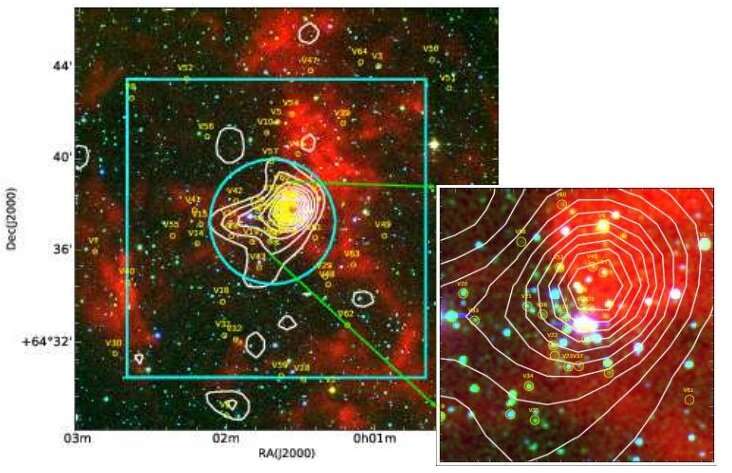February 4, 2020 report
Study investigates over 70 variable stars in the Sh 2-170 star-forming region

Using three ground-based telescopes, astronomers have conducted a long-term photometric monitoring of the Sh 2-170 star-forming region. The new observations have identified 71 variable stars in this region and provided essential information about their properties. Results of the study were presented in a paper published January 24 on arXiv.org.
Star-forming regions are essential for astronomers to better understand the processes of star formation and stellar evolution. Observations of such regions have the potential to expand the list of known stars, protostars, young stellar objects and clumps, which could be then be studied comprehensively in various wavelengths in order to get more insights into initial stages of stellar lifecycle.
Sh 2-170 is an HII star-forming region as it contains clouds of ionized atomic hydrogen. Observations have shown that the region is excited by the star known as BD+63 2093p, which is a member of the star cluster Stock 18, situated some 9,100 light years away, at the center of Sh 2-170.
Sh 2-170 is known to contain numerous pre-main sequence (PMS) stars, varying in age and mass, which makes it an ideal target to study variability properties of these stars. So a team of astronomers led by Tirthendu Sinha of Aryabhatta Research Institute of Observational Sciences (ARIES) in India has performed long-term monitoring of this region. They conducted deep and wide field optical observations of Sh 2-170 with the 1.3-meter Devasthal Fast Optical Telescope (DFOT), 0.7-meter Thai Robotic Telescope (TRT-GAO, at Gao Mei Gu Observatory) and 0.5-meter telescope of Thai National Observatory (TNO), located in India, China and Thailand respectively.
"In this paper, we have presented the multi-epoch deep Ic band (∼20 mag) photometric monitoring of the Sh 2-170 region to understand the characteristics of variables in the region," the astronomers wrote in the paper.
The observations identified 71 variables in Sh 2-170. Out of this sample, 49 variables were found to be probable PMS stars associated with Sh 2-170, while 17 stars are most likely main-sequence stars that belong to the field population.
Furthermore, 32 probable PMS stars were classified as Class III sources and the rest as Class II sources. Ten Class III and 19 Class III variables were found to be periodic. Fifteen main-sequence variables turned out to be periodic.
According to the paper, the majority of the PMS variables have masses between 0.2 and 3.0 solar masses and are from 0.1 to 2.0 million years old. Their rotation periods range from 4.0 hours to 18 days, with amplitudes varying from 0.1 mag to 2.0 mag. Based on these results, the researchers concluded that the studied PMS variables are most likely T-Tauri stars.
The research also found that the younger stars with thicker discs and envelopes seem to rotate slower than their older counterparts, what suggests a disc-locking mechanism.
"The bimodal period distribution and dependence of rotation period on IR [infrared] excess/accretion rate/disc mass are compatible with the disc-locking model. This model suggests that when a star is disc-locked, its rotation speed doesn't change and when the star is released from the locked-up disc, it can spin up with its contraction," the authors of the paper concluded.
More information: Variable stars in the Sh 2-170 HII region, arXiv:2001.08892 [astro-ph.SR]: arxiv.org/abs/2001.08892
© 2020 Science X Network





















